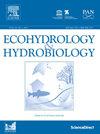Observed and estimated taxonomic diversity of different groups of aquatic organisms in the pristine rivers in the Biebrza National Park
IF 2.7
4区 环境科学与生态学
Q2 ECOLOGY
引用次数: 0
Abstract
The study focuses on the pristine rivers of the Biebrza National Park (BNP), an extensive area of wetlands, which holds significant biodiversity importance on a European scale. The aim of this work was to identify the taxonomic resources of the river network of this area and to compare the biodiversity of various aquatic organisms, and moreover, evaluate the field sampling effort required to identify the whole pool of taxa inhabiting the survey area. Fieldwork was carried out in 2021 at 25 survey sites, where the taxonomic compositions of five groups of organisms were identified: benthic diatoms, phytoplankton, macrophytes, benthic macroinvertebrates, and ichthyofauna and identified taxa have been presented in the appendix. The biodiversity indices of these groups were calculated, i.e. the species richness, and the Shannon and Simpson indices. The entire predicted biodiversity of these groups of organisms was also estimated. The Chao2 asymptotic taxonomic richness estimator for incidence data was used to calculate the additional number of survey sites that would be required to discover 80%, 90% and 100% of the anticipated taxonomic richness in each of the five groups of organisms. With the information on the species inhabiting the Biebrza Valley that this survey yielded, the biodiversity at a single site (alpha diversity) and within the entire area surveyed (gamma diversity) was estimated. The phytoplankton (475 taxa) and the benthic macroinvertebrates (308) showed the greatest diversity in taxonomic richness. In addition, there were 151 species in the benthic diatom group, 72 macrophyte taxa, and 24 fish species. The analysis showed, moreover, that if the fieldwork were continued, another 110 phytoplankton and 104 benthic macroinvertebrates taxa would be recorded for BNP, along with 40 further species of benthic diatoms, 9 more macrophyte species, and 2 more fish species. Alpha diversity was found to be high but gamma diversity was relatively low due to the homogeneous nature of the rivers surveyed (low beta diversity), effective conservation measures, and minimal human disturbances.
对Biebrza国家公园原始河流中不同类群水生生物的分类多样性进行了观察和估计
这项研究的重点是Biebrza国家公园(BNP)的原始河流,这是一个广阔的湿地区域,在欧洲范围内具有重要的生物多样性。本工作的目的是确定该地区河网的分类资源,比较各种水生生物的生物多样性,并评估鉴定居住在调查区域的整个类群所需的野外采样工作。2021年,在25个调查点进行了实地调查,确定了底栖硅藻、浮游植物、大型植物、底栖大型无脊椎动物和鱼形动物等5类生物的分类组成,并在附录中列出了已确定的分类群。计算了各类群的生物多样性指数,即物种丰富度,Shannon指数和Simpson指数。并对这些生物类群的整体预测生物多样性进行了估算。利用发生率数据的Chao2渐近分类丰富度估计值,计算了在5类生物中发现80%、90%和100%的预期分类丰富度所需的额外调查点数。利用本次调查获得的Biebrza Valley物种信息,估算了单个站点(alpha多样性)和整个调查区域(gamma多样性)的生物多样性。浮游植物(475个分类群)和底栖大型无脊椎动物(308个)在分类丰富度上表现出最大的多样性。底栖硅藻群151种,大型植物类群72种,鱼类24种。此外,分析表明,如果继续进行野外调查,BNP将再记录110种浮游植物和104种底栖大型无脊椎动物分类群,以及40种底栖硅藻,9种大型植物和2种鱼类。α多样性较高,而γ多样性相对较低,这主要是由于调查河流的同质性(低β多样性)、有效的保护措施和最小的人为干扰。
本文章由计算机程序翻译,如有差异,请以英文原文为准。
求助全文
约1分钟内获得全文
求助全文
来源期刊

Ecohydrology & Hydrobiology
Agricultural and Biological Sciences-Aquatic Science
CiteScore
5.40
自引率
3.80%
发文量
51
期刊介绍:
Ecohydrology & Hydrobiology is an international journal that aims to advance ecohydrology as the study of the interplay between ecological and hydrological processes from molecular to river basin scales, and to promote its implementation as an integrative management tool to harmonize societal needs with biosphere potential.
 求助内容:
求助内容: 应助结果提醒方式:
应助结果提醒方式:


